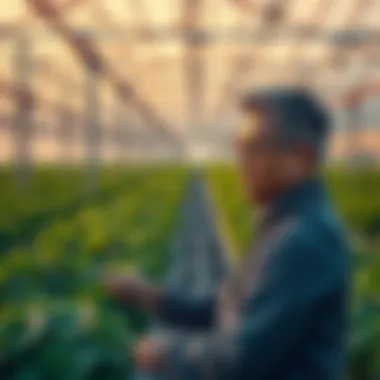Innovative Agricultural Greenhouses for Sustainable Farming


Intro
Agricultural greenhouses serve as a pivotal cornerstone in modern farming, intertwining innovation with sustainability. These structures not only provide a controlled environment for crops but also play a significant role in enhancing productivity. With the increasing global demand for food, combined with the challenges posed by climate change, the relevance of greenhouses in sustainable agriculture becomes even more critical. Let's embark on a journey to explore their design, functionality, and the vital implications they hold for the farming landscape.
Topic Overview
Definition and Importance
Greenhouses, often termed as glasshouses or hothouses, are buildings designed to create optimal growing conditions for a variety of plants. By utilizing transparent materials like glass or plastic, these structures capture sunlight while preventing heat loss. This results in a microclimate that allows for prolonged growing seasons and improved crop yields. Their importance continues to gain traction, particularly as the agricultural sector strives to innovate and address pressing issues such as food security and climate change.
Brief History and Evolution
The concept of cultivating plants in environmentally controlled structures isn't quite modern. Historical records indicate that the practices can be traced back to the Roman Empire. However, it wasn’t until the 17th century in Europe that greenhouses began to resemble what we know today. Early structures were rudimentary, primarily made of wood and glass. Over the years, advancements like heating systems and improved ventilation transformed these buildings into sophisticated agricultural tools. Now, innovative designs cater to various geographical and climatic conditions, making greenhouse farming accessible worldwide.
Key Techniques and Innovations
Sustainable Farming Practices
Sustainable practices in greenhouse agriculture involve resource-efficient methods that minimize environmental impact. Implementing techniques such as crop rotation, intercropping, and organic pest management help maintain soil health and biodiversity. Notably, integrated pest management (IPM) systems are employed to reduce chemical pesticide use, ensuring that the ecosystem within the greenhouse remains balanced.
Advanced Agronomic Technologies
The marriage of technology and agriculture has paved the way for innovative solutions in greenhouse design and operation. Automated climate controls, smart irrigation systems, and hydroponics are just a few examples of advancements revolutionizing operations. For instance, smart sensors can monitor temperature and humidity levels, adjusting conditions in real time to optimize plant growth. This not only enhances yield but also conserves water—an essential factor in sustainable farming practices.
Practical Applications
Step-by-Step Guides
Successfully implementing greenhouse farming requires a clear understanding of design, setup, and husbandry practices. Here’s a brief step-by-step guide:
- Site Selection: Choose a location with optimum sun exposure, good drainage, and proximity to water resources.
- Design Planning: Decide on the type of greenhouse based on crops to be grown, local climate, and budget considerations.
- Construction: Build the structure, ensuring proper ventilation and irrigation systems are included from the onset.
- Soil Preparation: Test and amend the soil according to the specific needs of the planned crops.
- Monitoring and Management: Employ technology to keep track of environmental states, and make adjustments as necessary.
Case Studies or Real-World Examples
Numerous success stories highlight the transformative power of greenhouses in agriculture. One notable example is the use of greenhouses in the Netherlands, where they have mastered the art of intensive farming. The integration of advanced technologies alongside traditional practices has resulted in remarkable productivity, with yields per square meter far exceeding global averages. Farmers in Israel have also successfully embraced hydroponics within greenhouses, demonstrating that innovation transcends geographical barriers.
"The future of agriculture is not just about growing more, but about growing smart and sustainable."
The continual evolution of agricultural greenhouses holds promising prospects for the future of food production. Embracing these innovations not only fortifies our food systems but also nurtures the environment.
Preamble to Agricultural Greenhouses
Agricultural greenhouses have come a long way in modern farming, and their importance cannot be overstated. These structures serve a vital purpose in controlling environmental factors that would otherwise hinder crop growth. From temperature to humidity, greenhouses allow farmers to create an optimal environment, thereby enhancing yield and quality of produce. This section lays the groundwork for understanding the complexities and nuances surrounding greenhouse operations.
One of the primary benefits of greenhouses is their ability to extend the growing season. In many regions, particularly those with harsh winters, crops can be sown earlier in the spring and harvested later in the fall, thanks to the climate-controlled conditions inside a greenhouse. This leads to increased productivity and the potential for higher profits. Furthermore, as global populations continue to rise and arable land becomes more scarce, greenhouses present a sustainable solution to meet the growing food demand.
However, establishing a greenhouse is not a one-size-fits-all solution. Several factors come into play, including the selection of materials, design configurations, and the specific climatic conditions of the location. Every detail matters; from the orientation of the greenhouse to maximize sunlight exposure to the choice of ventilation systems to prevent overheating. Thus, understanding these elements is crucial for anyone involved in agricultural practices or interested in optimizing their farming methods.
"The future of agriculture won’t just hinge on what we grow, but how we choose to grow it."
In summary, the significance of agricultural greenhouses extends beyond mere crop production; they represent a fundamental shift in how farming is perceived in a modern context. As we delve deeper into the specifics, it's these ideas that will underscore the ongoing innovations and implications surrounding greenhouse farming.
Definition and Purpose
Agricultural greenhouses can be defined as structures that provide controlled environments for growing plants. They are typically made of transparent materials that allow sunlight to penetrate, while offering protection from adverse weather, pests, and diseases. The purpose of these establishments transcends mere plant cultivation; they serve as scientific labs for farmers, allowing for experimentation with various growing techniques, crop selections, and climatic controls.
The overarching goal of any greenhouse is to optimize the conditions for plant growth. This means regulating light, temperature, humidity, and air circulation to create a microclimate conducive to healthy plants. By harnessing these factors, farmers are able to produce more food in less space, making greenhouses particularly valuable in urban agriculture where land is at a premium.
Historical Development
The concept of growing plants in controlled environments isn’t new. The origins of greenhouses date back to ancient Roman times when wealthy citizens constructed rudimentary versions to cultivate plants such as cucumbers. However, it wasn’t until the 16th century that glass greenhouses, or orangeries, became a fashionable trend in Europe.
Over the decades, greenhouse technology has evolved significantly. The introduction of different materials, like polyethylene and polycarbonate, along with expanded scientific knowledge, has transformed greenhouse design. The 20th century saw the rise of automated systems for temperature and humidity control, paving the way for highly productive greenhouse operations.
Today, greenhouses are found all over the world, adapting to various climates and agricultural practices. From modest backyard structures to expansive commercial facilities, the evolution of these greenhouses reflects not just advances in technology, but also a revolution in our understanding of agricultural science and sustainability strategies.
Types of Greenhouses
Understanding the types of greenhouses is crucial for anyone involved in agricultural practices and innovations. Each type has its distinct advantages and drawbacks, which can significantly influence crop yields, production costs, and environmental impacts. By selecting the right greenhouse type, farmers can optimize growing conditions based on climate, crop choice, and available resources. This aspect of greenhouse cultivation is a foundation of modern farming, shaping practices and policies alike.
Glass Greenhouses
Glass greenhouses, often viewed as the gold standard in terms of aesthetics and functionality, allow for maximum light transmission. The transparency of glass means that plants receive the full spectrum of sunlight, which is vital for photosynthesis. Moreover, the durability of glass offers long-lasting construction, making it a favored choice among larger commercial growers. However, practicality must be weighed against expense; glass structures tend to come with a hefty price tag.
For instance, a greenhouse constructed with single-layer glass might not provide adequate insulation in colder climates, potentially requiring supplementary heating. This impacts energy consumption and overall sustainability. To address this, many growers opt for double or even triple glazing, which enhances thermal efficiency and reduces heating costs.
Some key points regarding glass greenhouses include:
- Light Quality: Allows for excellent light diffusion.
- Aesthetic Appeal: Offers a professional look for commercial operations.
- Energy Costs: Higher heating costs in colder weather.


Polycarbonate Greenhouses
Polycarbonate greenhouses have been gaining traction due to their insulation properties and resilience. Made from a durable plastic material, they can withstand extreme weather conditions, including hail or high winds, making them a solid option in various climatic situations. This type of greenhouse often provides better insulation than glass, reducing the need for artificial heating.
In addition, polycarbonate materials can be treated to filter UV light, protecting plants while still allowing sufficient sunlight to penetrate. This is particularly beneficial for sensitive crops that can be damaged by direct UV exposure. On the downside, polycarbonate panels can yellow over time, which may decrease their light-transmittance capabilities.
- Resilience: Excellent for areas prone to severe weather.
- Insulation: Offers better thermal performance compared to glass.
- Aging: Can lose transparency with time due to UV degradation.
Film Greenhouses
Film greenhouses, typically constructed using polyethylene films, are an economical choice for many growers, especially in smaller operations. Lightweight and easy to install, these greenhouses can be erected quickly, facilitating a faster turnaround for production. However, they may not provide the same longevity or durability under harsh conditions compared to glass or polycarbonate.
These greenhouses are highly customizable, allowing growers to adjust the structure based on the specific needs of their crops. Nevertheless, the trade-off for cost-effectiveness is a lower lifespan, generally lasting between 4 to 6 years before the plastic begins to degrade.
Advantages include:
- Cost-Effective: Affordable to set up.
- Quick Assembly: Easy to install and modify.
- Short Lifespan: Requires replacement every few years.
Retractable Roof Greenhouses
Retractable roof greenhouses represent an innovative leap in design, offering farmers the flexibility to control environmental conditions dynamically. By being able to open or close the roof, growers can enhance ventilation during hot days and protect plants from sudden rain or frost. This adaptability can significantly contribute to optimizing growing conditions.
These greenhouses are ideal for climates with variable weather and can support a diverse range of crops. However, the mechanical systems required for the retractable mechanisms can complicate maintenance and increase initial costs. Farmers must also consider the potential for mechanical failures, which could expose crops to unplanned environmental stressors.
In summary, retractable roof greenhouses offer:
- Flexibility: Control over ventilation and temperature.
- Diversity: Suitable for various crops and weather conditions.
- Maintenance Challenges: Complex systems can require more upkeep.
In choosing the type of greenhouse that best suits agricultural goals, careful consideration of each option is essential. By weighing the characteristics and associated traits, farmers can make informed decisions that enhance both productivity and sustainability.
Design Considerations
When delving into the construction and operation of agricultural greenhouses, several design considerations come to the forefront. Proper attention to these factors can significantly impact the efficiency and productivity of the greenhouse as well as the overall health of the crops. Let's explore the key elements that play into the design of a greenhouse, highlighting their importance and benefits.
Location and Orientation
The importance of location cannot be understated. The placement of a greenhouse dramatically affects its overall effectiveness. Factors such as sunlight exposure, wind patterns, and nearby obstacles like buildings or trees should shape decisions. Ideally, a greenhouse should face south or southeast to capture maximum sunlight throughout the day.
Key points to consider include:
- Sunlight: Determines plant growth rates. A well-situated greenhouse can harness ample light, boosting photosynthesis.
- Wind exposure: Protecting the greenhouse from strong winds can reduce heating costs and minimize structural damage.
- Accessibility: Proximity to water sources and ease of access for maintenance can influence logistical efficiency for farmers.
Structural Integrity
A greenhouse is only as good as its structure. The materials used and the way the greenhouse is built will dictate its durability, safety, and long-term viability. Ensuring solid structural integrity can prevent potential failures that would disrupt operations.
Considerations such as:
- Frame construction materials: Aluminum and galvanized steel provide sturdy frameworks while resisting corrosion.
- Roof types: A pitched roof allows for rain runoff and enhances light distribution. Flat roofs can hold on to snow or water, risking collapse.
- Anchor stability: Proper anchoring is vital in areas exposed to high winds. The right foundation can prevent structural shifts over time.
"Investing in robust design is investing in a successful growing season."
Ventilation and Temperature Control
Maintaining a consistent temperature is crucial for crop yield. Effective ventilation systems help control excess heat and humidity, preventing scenarios where crops might wilt or grow mold.
- Natural ventilation: High vents at the apex and sidewall vents can facilitate air circulation, allowing warm air to escape.
- Mechanical options: Exhaust fans work wonders in regions with extreme temperature variances or high humidity, promoting a stable growing environment.
- Thermal screens: These can be utilized to retain warmth during colder months, maximizing energy usage.
Water Management Systems
Efficiently managing water resources is essential for greenhouse productivity. A well-planned water management system can promote healthy plant growth while conserving water.
Some effective methods include:
- Drip irrigation: Targets the plant root zone directly, reducing waste and improving water efficiency.
- Rainwater collection systems: Capturing and utilizing rainwater can lower dependency on municipal water sources and reduce costs.
- Soil moisture sensors: These allow for precise watering based on actual need rather than a fixed timetable, promoting robust growth while conserving resources.
In summary, considering these design elements in depth ensures that a greenhouse operates efficiently. The integration of location, structural integrity, ventilation, and water management can lead to a thriving environment for crop production.
Technological Innovations
Technological innovations in agricultural greenhouses represent a crucial shift in how we cultivate crops. As global population increases alongside growing food demands, innovations are no longer just optional; they have become essential. Modern advancements enhance efficiency, productivity, and sustainability in ways we could only imagine just a few decades ago. This section discusses several pivotal technological innovations that are shaping the future of greenhouse agriculture.
Automated Climate Control
In today's agricultural scene, automated climate control systems stand out for their ability to optimize growing conditions. These systems utilize sensors to monitor temperature, humidity, and even light levels inside the greenhouse. With data collected in real-time, the system can adjust ventilation, heating, and cooling, allowing plants to thrive without human intervention. This not only boosts yields but also conserves energy by ensuring that resources are used judiciously.
Benefits of Automated Climate Control Include:
- Reduced Labor Requirements: Automation lessens the need for constant monitoring and manual adjustments.
- Consistent Growing Conditions: Plants grow best in stable conditions; automated systems enhance this stability.
- Energy Efficiency: By only using energy when necessary, growers can significantly lower operational costs.
Such technologies demand initial investment but tend to pay off in the long run, showing a hidden potential for profit that becomes apparent over several harvests.


Hydroponics and Aeroponics
The shift from traditional soil-based cultivation to hydroponics and aeroponics marks a significant innovation in agriculture. Hydroponics involves growing plants in nutrient-rich water, completely eliminating the need for soil. Similarly, aeroponics takes it a step further, suspending roots in the air and misting them with nutrient solutions. Both methods provide a more controlled and efficient way to grow crops.
Advantages of Hydroponics and Aeroponics:
- Space-Efficient: These systems require much less space than conventional farms, making them suitable for urban settings.
- Faster Growth Rates: Plants grown in these environments tend to grow faster due to improved nutrient uptake.
- Reduced Water Usage: Both methods use significantly less water compared to traditional agriculture methods, an essential factor in water-scarce areas.
Moreover, hydroponics and aeroponics face fewer pest problems compared to soil-grown crops. This means reduced reliance on pesticides, aligning with sustainable farming practices.
Energy Efficiency Technologies
Energy efficiency technologies play a vital role in modern greenhouse practices. From solar panels to geothermal heating, these technologies reduce reliance on traditional power sources. Greenhouses increasingly incorporate energy-efficient designs and renewable energy systems. By doing so, they not only lower costs but also diminish their environmental impact.
Key Technologies in this Field Include:
- Solar Energy Systems: Harnessing solar energy can reduce electricity costs associated with heating and lighting.
- LED Grow Lights: Compared to traditional grow lights, LEDs consume less energy and produce less heat, translating to better energy efficiency.
- Heat Recovery Systems: These systems can capture waste heat and reuse it, significantly decreasing energy usage.
Interestingly, these technologies also enhance a grower’s marketability. A greenhouse that uses renewable energy is attractive to eco-conscious consumers, providing an added marketing edge.
"Investing in technological advancements not only meets immediate crop needs but also strengthens the economical framework for sustainable farming in the long term."
As we move forward, the importance of these technological innovations in agricultural greenhouses cannot be overstated. They serve not only to boost productivity and efficiency but also to ensure that the environmental impact of farming remains as minimal as possible while still meeting the needs of growing populations.
Crop Cultivation in Greenhouses
Crop cultivation within greenhouses serves as a cornerstone for advancing modern agricultural practices. It allows for a controlled environment where various factors, such as temperature, humidity, and light, can be meticulously adjusted to favor plant growth. This method offers the potential to maximize yields and extend growing seasons, leading to increased food production, especially in regions facing climatic challenges. Moreover, greenhouse cultivation enables farmers to engage in year-round farming, aligning food production more closely with market demands.
Selection of Crops
Choosing the right crops is essential for successful greenhouse cultivation. Not all plants thrive equally under greenhouse conditions, so understanding which varieties perform best is crucial. Factors to consider include growth duration, market value, and the ability to resist pests and diseases common in enclosed spaces. Crops like tomatoes, cucumbers, and peppers are popular in greenhouses due to their high yield potential and adaptability to various growing systems.
Interestingly, some crops can significantly benefit from greenhouse environments. For instance, leafy greens, such as lettuce and spinach, grow quickly and can be harvested multiple times throughout a year. This creates a consistent business opportunity for farmers, as fresh produce can be made available with less downtime.
Growing Techniques
Vertical Farming
Vertical farming is an innovative approach that maximizes space utilization in greenhouses. By layering crops upwards rather than spreading them out across the ground, growers can significantly increase their yield per square foot. This method is particularly advantageous in urban settings where land is limited.
A key characteristic of vertical farming is the use of hydroponic or aeroponic systems, where plants are grown in nutrient-rich water or mist instead of soil. This not only conserves water but also minimizes the risk of soil-borne pests and diseases, making it a desirable choice in densely populated areas. The unique feature of this method is its water-efficient nature, which resonates well with sustainability goals and urban food challenges.
However, it's worth noting that vertical farming might require higher initial investment for technology and infrastructure, which could be a deterrent for some. Still, as technology advances and costs decrease, its adoption is likely to increase.
Companion Planting
Companion planting involves strategically growing different crops in proximity for mutual benefits. This method has gained traction in greenhouse farming due to its natural pest control and enhanced growth potential. For example, planting basil alongside tomatoes can enhance the flavor and repel certain pests, making it a beneficial choice for farmers looking to decrease their reliance on chemical pesticides.
A notable characteristic of companion planting is its ability to improve nutrient uptake, as different plants can complement each other's growth needs. This diversity within the greenhouse not only keeps the environment dynamic but also enhances overall productivity. However, careful planning is required to ensure that companion plants do not compete for resources excessively.
In summary, both vertical farming and companion planting present unique opportunities and challenges in greenhouse crop cultivation. As farmers explore these methods, they can contribute to innovation and sustainability in agriculture while also addressing market demands effectively.
Pest and Disease Management
Pest and disease management is a critical pillar in the success of agricultural greenhouses. The enclosed nature of greenhouses provides a controlled environment that can be blissful for crops, but it can also serve as a paradise for pests and pathogens. Managing these threats effectively is fundamental not only for maintaining healthy plants but also for maximizing productivity and ensuring economic viability.
A robust pest and disease management strategy focuses on prevention, monitoring, and response techniques, aiming to minimize the impact of these threats while promoting sustainability. By employing various methods like Integrated Pest Management (IPM) and biocontrol techniques, greenhouse operators can create a healthier growing environment. This strategic approach aids in reducing chemical usage, which is beneficial for both the environment and consumer health.
Integrated Pest Management (IPM)
Integrated Pest Management (IPM) combines different management practices to minimize pest damage effectively. The hallmark of IPM is its holistic approach, which incorporates biological, cultural, physical, and chemical methods.
- Monitoring and Identification: Continuous monitoring is key. Operators must identify pest populations and their life cycles. This determination allows targeted actions.
- Cultural Practices: Implementing practices such as crop rotation, intercropping, and maintaining healthy soil can significantly reduce pest populations and disease outbreaks.
- Biological Controls: Leveraging natural predators like ladybugs or parasitoids can help keep pest numbers in check without reliance on chemical insecticides.
- Targeted Chemical Use: When necessary, using insecticides or fungicides as part of a larger strategy can help preserve beneficial organisms while achieving effective control of harmful ones.
Using IPM reduces the risk of pests developing resistance while minimizing chemical residues on crops. Ultimately, IPM supports the goal of sustainable agriculture by promoting healthy ecosystems within the greenhouse.
Biological Control Methods
Biological control methods involve the use of living organisms to control pests and diseases. This strategy focuses on harnessing nature’s own balance to keep greenhouse crops healthy.
- Predatory Insects: Insects such as lacewings, spiders, and predatory mites target harmful pests. By introducing these beneficial insects into the greenhouse, growers can rely on nature instead of chemicals.
- Pathogenic Organisms: Another method is utilizing pathogens that specifically target pests. For instance, the fungus Beauveria bassiana can infect and kill certain insect pests, acting as a biological insecticide.
- Microbial Solutions: Injecting specific bacteria or fungi that promote plant health can deter diseases. For example, Bacillus thuringiensis (Bt) produces toxins that specifically target caterpillars but poses no risk to beneficial insects or humans.
Adopting biological control methods can lead to healthier plants, less chemical dependency, and improved crop yields. The long-term benefits of this practice contribute to a more sustainable and ecologically friendly greenhouse environment.
"Investing in effective pest and disease management strategies not only safeguards crops but also preserves the integrity of agricultural ecosystems for future generations."
In summary, integrating pest and disease management strategies in agricultural greenhouses is vital for sustainable farming. Utilizing methods like IPM and biological control bolsters plant health, contributes to food security, and encourages environmentally responsible practices.
Economic Viability


Economic viability is a cornerstone for the future of agricultural greenhouses, underscoring their potential not just as productive spaces, but as economically sound investments. In a world increasingly focused on sustainable practices, understanding the financial implications of greenhouse operations becomes essential. Greenhouses can significantly boost yield per acre, providing farmers with a continual source of income, even in challenging climates. Moreover, they allow for the extension of growing seasons, enabling farmers to capitalize on higher market prices by growing off-season crops.
Evaluating the economic viability involves multiple factors, such as initial investment, operational costs, and market potential. Farmers must weigh these factors carefully to ensure that the greenhouse farming enterprise not only covers its expenses but also contributes positively to their overall economic health.
Cost Analysis and Return on Investment
When delving into cost analysis, one must consider both the fixed and variable costs associated with operating a greenhouse. Fixed costs might include the purchase of the greenhouse structure itself, land lease or ownership, and the installation of key infrastructures like heating and cooling systems. On the other hand, variable costs encompass labor, water, nutrients, and other day-to-day operational expenses. More often than not, the initial investment can be quite high, especially for advanced greenhouse designs like hydroponics or aeroponics systems.
However, the critical question remains: how can these costs translate into profits? To answer this, one has to look at the return on investment (ROI). ROI calculation is crucial, as it captures the profitability of greenhouse operations. For instance, if a farmer invests $100,000 in a greenhouse but generates earnings of $120,000 in a year, the ROI would be 20%. Many studies suggest that greenhouse operations can deliver ROIs ranging from 15% to over 30%, depending on crop type and market demand.
"Understanding your costs and how to manage them can be the difference between thriving and just surviving."
Looking forward, ROI can also improve with advancements in technology and better supply chain management, leading to reduced per-unit costs and increased output efficiency. For instance, investing in automated systems like climate control can significantly enhance yields while minimizing labor costs.
Market Trends for Greenhouse Produce
The marketplace for greenhouse produce is continually evolving, shaped by consumer demands and technological advancements. As the global population grows, so does the demand for fresh, locally sourced food. Consumers today are leaning towards organic produce, prompting growers to adapt their methods to meet this trend. The integration of sustainable practices not only aligns with consumer ethics but often opens up premium channels in the market with higher profit margins.
Another noteworthy trend is the increasing popularity of niche products — exotic vegetables, specialty herbs, or even edible flowers. This shift allows for unique selling propositions that can lead to better prices. In fact, marketplaces and restaurants often seek unique produce, allowing farmers to diversify their revenue streams.
On the flip side, competition in the greenhouse sector has risen sharply, driven by the availability of technologies that lower the barrier to entry. This means that staying abreast of current market trends and forecasting them accurately becomes essential. Attending agricultural fairs and staying involved in online communities can help farmers keep a finger on the pulse of the industry. Sites like Reddit or Farmers' Markets might be good resources for gauging consumer preferences.
In a nutshell, understanding and optimizing for economic viability is fundamental for anyone venturing into greenhouse agriculture. As innovations continue to unfold, and market trends shift, farmers must remain adaptable, informed, and strategic to ensure their greenhouse operations not only succeed but thrive.
Environmental Impact
Understanding the environmental impact of agricultural greenhouses is crucial in today's world where sustainable practices can no longer be an afterthought. Greenhouses offer farmers a whole array of benefits, including extended growing seasons and enhanced protection from pests and diseases, but they also come with environmental considerations that need to be carefully weighed. This section delves into some specific elements and benefits of greenhouses as well as the key environmental considerations.
Sustainability Practices
Sustainability practices in greenhouses are not just about bias towards eco-friendly methods; they encompass a multifaceted approach to agriculture that can mitigate negative environmental impacts. Here are some significant practices:
- Use of Renewable Energy: Many modern greenhouses integrate solar panels or wind turbines to power their operations. This reduces reliance on fossil fuels.
- Water Conservation: Rainwater harvesting systems are implemented to utilize natural water sources more effectively. Drip irrigation techniques minimize water waste significantly.
- Soil Health Management: Implementing crop rotation and organic fertilizers maintains soil nutrients and reduces chemical runoff.
- Integrated Pest Management (IPM): By using biological controls rather than harsh chemicals, growers can limit pest populations without harming the environment.
These practices not only help in reducing the ecological footprint of greenhouse operations but also contribute to better crop yield and quality, ensuring that farmers can make a living while being stewards of the environment.
Carbon Footprint of Greenhouses
The carbon footprint of agricultural greenhouses becomes a pertinent topic when discussing their role in climate change. Essential factors to consider include:
- Energy Consumption: Greenhouses require substantial energy for heating and cooling, especially in regions with harsher climates. The more efficient the energy use, the lower the carbon emissions. Innovations such as thermal screens and energy-efficient heating systems can mitigate impact.
- Material Choices: Building materials play a significant role in the overall carbon footprint. Lightweight materials such as polycarbonate can reduce transportation emissions and energy needs due to lighter weight.
- Transportation: The carbon cost associated with transporting crops grown in greenhouses should not be overlooked. Localized production can alleviate some of this burden, but optimization of supply chains is fundamental for reducing overall emissions.
"By focusing on sustainability and meticulously managing the carbon footprint, greenhouse agriculture can become a pillar of modern eco-conscious farming."
Future Prospects
The future of agricultural greenhouses is a topic of extensive importance. As global challenges like climate change, population growth, and food security loom over the agricultural sector, these structures are expected to play a pivotal role in sustainable farming. The advancements in greenhouse technology, coupled with innovative farming methods, could significantly enhance crop production while reducing environmental impacts.
Challenges Facing the Industry
The hurdles that the greenhouse farming industry faces are numerous. For one, high initial costs can be daunting for small-scale farmers. Establishing a modern greenhouse often requires considerable investment in infrastructure and technology. Additionally, fluctuating climate conditions have raised concerns around the reliability of harvests each season.
"The biggest challenge might not just be the costs but also the ability to adapt to rapidly changing environmental conditions."
Labor shortages also pose a significant challenge. With many younger generations moving away from agriculture, finding skilled workers to manage these high-tech systems is increasingly difficult. Moreover, pests and diseases continue to evolve, necessitating constant updates in pest management strategies and greenhouse designs.
Innovations on the Horizon
Despite these challenges, the horizon looks promising for greenhouse agriculture. New technologies are on the brink of advancing the industry's capabilities tremendously. Among these innovations, artificial intelligence stands out. It can optimize everything from watering schedules to energy usage, allowing farmers to cultivate crops more efficiently and sustainably.
Another area brimming with potential is the integration of renewable energy sources. Solar panels and wind turbines can be utilized within or around greenhouses, helping to offset energy costs and lower the carbon footprint.
Some researchers are exploring vertical farming techniques alongside traditional greenhouse methods. Implementing vertical systems could drastically increase yields per square foot while also conserving water and land resources.
Furthermore, biotechnological advancements in seed development form another exciting avenue. These seeds, designed to thrive in controlled environments, can lead to increased resistance against diseases and enhance nutritional value. This development could push the boundaries of what can be grown in greenhouses.
The synergy of technology, sustainability, and innovative cultivation practices hints at a future where greenhouse farming isn't just a trend but a foundation for food security and environmental harmony.
Culmination
The role of agricultural greenhouses has never been more pivotal in the landscape of modern farming. As we reflect on the multifaceted functions and innovations of these structures, a few critical points come into sharper focus.
First and foremost, greenhouses serve as a linchpin in pushing the boundaries of crop cultivation. By creating controlled environments, farmers are empowered to grow a diverse array of plants in virtually any climate, significantly enhancing food production and security.
Moreover, these innovations in greenhouse technology do not merely optimize the growing process; they also prioritize resource efficiency. With modern systems like automated climate control and energy-efficient construction materials, greenhouses have become models of sustainability in agriculture. This dual focus not only boosts productivity but also minimizes the environmental impact, aligning agricultural practices with the urgent need for sustainable methods in an ever-changing climate.
Further, the economic viability of greenhouses cannot be understated. They offer farmers a tangible pathway to increase their yields and marketability, ensuring that they can better compete in an ever-evolving agricultural sector. It's clear that investing in greenhouse technologies can yield significant returns, making them an appealing option for both new and seasoned farmers alike.
Key Takeaways
- Agricultural greenhouses are essential for maximizing crop yields, enabling cultivation in various environments.
- Innovations in technology make these structures more energy-efficient and sustainable.
- Greenhouses enhance the economic prospects for farmers, ensuring a more stable income stream while promoting food security.
Call for Sustainable Practices
The future of agricultural practices lies in sustainability. Farmers and stakeholders in the agriculture sector must look towards greener solutions. Adoption of greenhouse technologies is not just a matter of improving one's yield; it is a commitment to preserving the environment for generations to come. Encouraging sustainable practices within greenhouse production—such as using renewable energy sources and recycling water—will set the stage for an agricultural doctrine that prioritizes both productivity and ecological balance.
The path is clear, and the possibilities are boundless. By embracing modern greenhouse practices, the agricultural community can pave the way for an era where food security coexists with environmental stewardship. A holistic approach that integrates farmers' knowledge with innovative technologies can lead to a more resilient food system.



